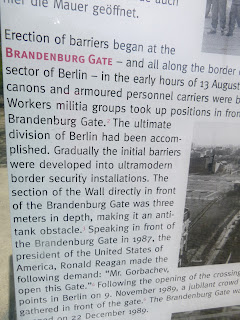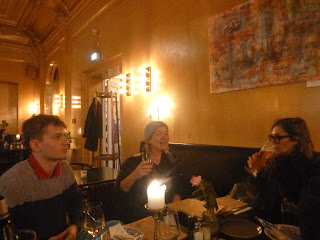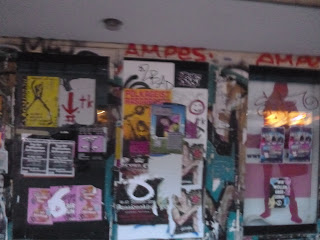“Please Change”: on Gallery Week, the Naked Tea Party, Dance Protests, Community Gardens, and Mayday in Berlin
On the way to Alexanderplatz, the tram announcer says: the tram terminates here, please change. What do they want me to transform into, wonders @seashipsailing. It was the middle of a long strange weekend, of late nights out in Berlin, to a favorite tapas place, a Vieux Carré in a dark cocktail bar, a trip to Brecht's theater for late night dancing after a night of gallery hopping on Friday, through a whirlwind. Dancing at @sisyphosberlin well into Sunday, with my yoga teachers. Off to the naked tea party, between the techno rooms, chasing a feeling long into the night.
The Naked Tea Party a manifesto explains:
“N A K E D.
A physical expression and deeply symbolic.
The Naked Tea Party celebrates and encourages acceptance, truth, diversity, and life in all of its forms. An experience offering the potential for healing, here we challenge modern day consumerism and standard beauty norms. With a childlike innocence, we meet in the warmth of community and the dreamiest soundscapes, in a consensual playground of celebration and liberation. We rise up as we remember the innate beauty and strength of our bodies, our hearts, and our deepest souls, and awaken to the great gift of witnessing that truth in others. You are welcome here.”
The dancing is plenty, the techno moving through us.
Everyone is trying to figure something out. My favorite show of the week was about activism.“JOY & REVOLUTION! SUR LA PLAGE, LES PAVÉS on the beach, the paving stones @clementclaudius @diskursberlin curated by Peter Ungeheuer,” says @lastnightinberelin, snapping photos. With bricks and police barricades, images of tyrants and forces of freedom, resonant layers and references many of us harkern to... the beach beneath the streets. It's everywhere.
Sunday, the sun out, thousands careen through the city on a drum and bass public bike ride.
On we ride, looking out, people are still pouring into Sisyphus dance club.
We find ourselves on the tram to @aslongasitlasts, at the @christian
awe studio, taking in the works of @andreastemplin, climate clocks ticking, chatting with @christina_dimitriadis_13 about borderlands and peripheries, poetry and stories, new friends, looking at the water, at the city, the homeless camps, where people find homes, before they are kicked out. The conversations are many here. Movement is constant.
Happy Mayday everyone, I think, looking at the march through Alexanderplatz, on Monday morning. As you are out enjoying your free time today, thank the labor movement, says my yoga teacher, to start the day. Workers got us the eight hour work day, down from 12. They got us time to dream and hatch plans..thank you labor movement. The day bursts with history and feelings, sunshine and music, marches and ideas.
On I ride through the city, watching the public spaces, full of people, vacant lots, buildings rising, social movements ebbing, left and right, the rebuilding that seems to be every day here. Off to Comenius Garden Richardstrasse, a garden in Neukolln based on the writings of philosopher, John Amos Comenius:
"How can we succeed in planting a new paradise?" This was the question that the polymath Johann Amos Comenius (1592-1670) tried to answer again and again by "seeing oneself, speaking for oneself and acting for oneself"... self-determination is the “paradise method”, the method for the completion of creation as a GARDEN …The Comenius Garden is designed according to Comenius' concept of society as a way of life through eight school areas. In the "School of Prenatal Becoming", at the entrance from Karl-Marx-Platz, there is a walnut as the tree of life. Then the playground joins as the mother school area. With entry into the fenced garden, to which the educational facilities on site have a key, the six-class "common school" begins, including violet beds, rose groves, meadow carpets, mazes, medicine gardens and a paradise for the soul.”
And off to Gorlitzer Park, for some sunshine and music, before the Mayday demo at six.
Revolutionary Berlin tour recalls. “Every year since 1987, Kreuzberg has seen protests on May 1. "Revolutionary May Day" combines Germany’s knack for organization with Berlin’s predisposition for nihilism..” It's a story of a
“... neighborhood uprising of 1987, 30+ years of revolutionary demonstrations, refugee, protests at Oranienplatz, struggles against rising rents…”
A little bit more into the history of the neighborhood action I am joining. “Kreuzberg stages an alternative celebration marking International Workers’ Day on 1 May 1987. What begins as a peaceful event during the day descends into rioting that night. A supermarket burns to the ground, whole streets are set on fire and 250 police officers are injured. The next morning, parts of Kreuzberg lie almost in ruins. It is the start of a cycle that will see the district erupt into violence on 1 May for many years to come.” Everyone who joins the Mayday actions is part of this cycle, of protests and history, intermingling, moving through us, through the city, its streets and the people filling them. Ghosts of president McKinley here, the Haymarket there. In the US, we recall the Haymarket Martyrs, anarchists, killed by police during labor unrest in May, 1886 in Chicago, who Emma Goldman dreamed about, their journey inspiring her anarchism.
In Berlin, many recall May 1987, when, according to Wiki:
“particularly severe rioting in Kreuzberg led to the Berlin police having to completely withdraw from the eastern area of Kreuzberg, SO 36.... Since then, autonomists and anti-fascist groups have held so-called "Revolutionary 1st of May Demonstrations" almost every year.”
And Monday was no different.
Mayday is jayday in Berlin, I think looking out at the people dancing, singing; music in the air, beers in everyones’ hands. A national holiday for workers and ideas, freedom of thought, beer bottles and black blocks, djs and live music, public spaces filled with bodies and ideas, revolutionary groups and anarchists, clashes with cops, cattling in the marchers, Armenian and Palestine, queer and communist demonstrators, smoke in the air, thousands of us marching and chanting: “a ati, anti-capitalista!!!” I could write down all of them... “No nations! No borders! No deportations!” “Siamo tutti anti fascistsi!” “Oy Oy oy!” “May first is my struggle!” “Eat the rich, not animals!!! With marchers in black, we make our way to Kreutzberg, smoke in the air, the police pushing, laying in wait, moving in Kreuzberg, trying to avoid the repeat. They cattle us in near Kotti. More fireworks, more police screams and orders. Carrying my bike, one man screams at me. Solidarity crumbling. He starts to fight me. He’s drunk. I ignore him. Finally, we sit in a cafe and watch it all. Police vans zoom up and down the street. Go home, they implore everyone. The police blare their sirens. No one is following. Most everyone staying as I ride back to Prenzlauer Allee and home.
Classes and chats with friends all week, I’m still thinking about Mayday. People are still cleaning up the broken bottles at Kotti when we drop by the next day. We talk about social movements for health in Eastern Europe and Russia, and a few friends from Georgia met me at Schokoladen to listen to music and talk late into the evening. The teenager is writing poetry and finding an audience. It's getting better each day here. What a fascinating year.
Tuesday, we sit in the big lecture hall on Ihnestrasse 22 and talk about what happened here, actually in class. In a long conversation about knowledge production, the professors make references to the history here in Ihnestrasse 22...where we are sitting, the eugenics research conducted from 1927 to 1945. "The building at Ihnestraße 22 in Berlin-Dahlem, which today houses part of the Otto Suhr Institute of Political Science, looks back on a drastic history of dehumanization and racism. From 1927 to 1945 it housed the main building of the "Kaiser Wilhelm Institute for Anthropology, Human Heredity and Eugenics" (KWI-A), for which it was specially built. The "KWI-A" soon became a prominent institute for human genetics, "race research" and eugenics: Under its umbrella, scientists tried to prove that diseases and behavior were hereditary, as well as traits by which they tried to support the idea of human "races". The KWI-A was also directly involved in eugenic measures of the German state. In this way, institute employees legitimized the forced sterilization of people – as early as the Weimar Republic. Finally, at Ihnestr. 22, scientists also conducted research on the bodies of people who were murdered in National Socialist extermination camps and sanatoriums. In particular, Sinti and Roma, Jews, Black people and disabled people fell victim to the work of the KWI-A."
The cruelty weighs on me. I think about it when people scream orders here. The elders on the street, with their scary righteousness, telling you how to do this or that, when you cross the street. I think about how many endure it, recalling, feeling, thinking about my friend forced from his home in Kosovo in 1998, walking all night with his family after the Serbs told them to leave, a homeless man on the subway killed by a marine, a strange dream about suitcases, carrying us, holding us inside, each of us carried away into the night, disappearing, lives once here disappearing, passing from this life to the next.
Raymond Diskin Black posted a hopeful note:· “I never knew of Connie Converse, the singer-songwriter who moved to New York City at the age of 20 in 1944 and created folk music worthy of Dylan a decade or more before anyone was doing anything like that. I just listened to a segment about Connie on WNYC. She never found commercial success and left New York for Ann Arbor in 1963, ultimately packing up her VW Beetle in 1974 and completely disappearing, never contacting anyone again, including her brother with whom she was close. If Connie is still out there somewhere she is 98 years old. Thanks to a few people, including her brother Philip, the author Howard Fishman, graphic artist Gene Deitch, and one friend from her NYC days who is now 100, the few recordings of her music - unavailable anywhere until 2004 - have been collected together. I found Connie on Spotify. Her songs are quite extraordinary given when they were written. They are also deeply moving. Many of these recordings were done at informal apartment jam sessions in the Village and Hell’s Kitchen in the late 1940s and 1950s. You can hear Connie and other people talking before she sings each song while playing her guitar. I swear you can hear people lighting their cigarettes as they talk.”
Friday, we bike through a gorgeous day, exploring the garden colonies of South Neukölln Berlin... And the highways looming. The city says it needs housing so it's developing a highway, Bundesautobahn_100, originally started as part of a plan to create a car friendly city. It's a fifties plan, that feels out of step with the times. Today, the plan will cost us housing, green spaces, and cultural spaces, including clubs. Feels like New York. Robert Moses would love it. The city of Berlin hopes to create more housing, as well as maintain green spaces. The highway points us backward. It's so eighties, says my friend Peter, riding and showing me about. More cars, less green. “It's the 1980’s view. No view. No perspective,” he says, looking at the highway. “Even if people don’t want it, you have to muscle it in.”
On we ride to the garden colonies, chatting about the history of the community gardens in Berlin. Built by squatters and former soldiers, many who were hungry and left to fend for themselves after the first world war, today these clusters foster a delicate urban ecology of immigrants and refugees, where urban ecologists foster innovations in sustainable urbanism. Like all urban spaces, they are subject to contestations, battles over control, clashes between personalities. Still they help make Berlin livable and humane, and friendly to outsiders.
Finishing our tour, Peter takes me to Kantine zum Nussbaum la Radu, a Romania restaurant, and social center for the accompanying garden cluster, where we enjoy some cevapcici, Romanian balkan sausage, beer, complimentary schnapps, with dessert. We talk about the new government and its emphasis on car culture here in Berlin. There is no united garden movement here, just different gardens and interests being defended. Yet, each garden offers different perspectives, on a life balance, for mental health, for social welfare, etc. Some people don’t travel. This is it. This is where they live. The green space is necessary. Tracing these networks in Green Maps with Wendy Brawer in New York, Peter eventually brought the project to Berlin, mapping social capital and connection, older people and young talking with each other.
The tensions are always here, East vs West, even here, where generations and ideas intersect. Still, the gardens open space and ideas. Yet, for how long? They are the places where the future of the city is decided, one lot at a time.
Over the years, Berlin has been hospitable, welcoming to refugees, particularly in 2015. It was also workforce development, says Peter. A quarter of the population is retired. Someone has to do the work, keep things moving. They also need green space and housing, education and spaces to grow.
Saturday, friends are in town, exploring the history. Karina’s mother was outside Dresden during the war, living history. She’s out all weekend, looking to understand it. Marches for marajana legalization fill the streets outside our apartment. I run into @clementclaudius, from the Beach Beneath the Streets show, at the dance protest on Karl Marx Allee, the police harassing him, asking for his ID for bring a sound bike to the demo protesting the highway extension for A100, that will bulldoze the community gardens, clubs, even some of the housing the city desperately needs. Cars vs gardens, a global struggle from Berlin to Brooklyn. Save the gardens, save the city.
It's a story taking place all over the world. In New York, they are shutting down the trains — a historic act of resistance and an homage to 1987's Day of Outrage #justiceforjordanneely, killed earlier in the week, on the subway.
Protests all day, all over the world, club night, out into the spring with NY friends, dancing at Klunkerkranich, unpacking the history of the city.
Sunday, back to Sisyphus for a tea dance, outside in the sun, biking by the train station, across the water, stopping for Polish food and the show at Verwelterhaus, where our big show is happening in late July early August. The cemetery is popping with colors. Niels is holding court in the old cemetery, at the Picto Plasma finessage. I wonder what's next, what home will feel like after a year of this exploration, what will even be home. Three months before we return.
After dinner, we talk about it all, the teenager djing, spinning our favorite Odetta and Pete Seegar songs. “In between two tall mountains, there's a place they call lonesome,” sings Connie. Bear tells me about Connie Converse.
Huh, I just learned about her.
Springtime story after story, Connie lost and now found, Pete singing, “Both Sides Now” entering the other half of fifty:
“...Oh, but now old friends they're acting strange
And they shake their heads and they tell me that I've changed
Well something's lost, but something's gained
In living every day,” sings Pete, doing his best Joni.
Somethings lost, somethings gained.
“I leave the house as a boy and come home a man,” says the teenager, on their way, to take the train to school for their AP history exam, captivated and haunted by the history.
“Please change,” announces the tram conductor. “Terminus. You may continue to the service stop.” No one is sure what we are changing into. Mass shootings every day in the US, dance protests in Berlin. Still we stop; we depart and change. It's constant, the flux. Dr B knew it; he saw it over and over, teaching history for decades. So do we. Kids grow up, find their own songs, as cities change, highways vs gardens, martyrs fade, their memories reminding us, the dreams are many.

























































































































































































































































































No comments:
Post a Comment